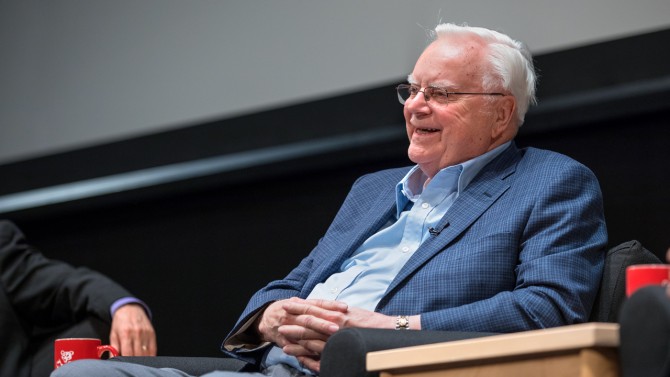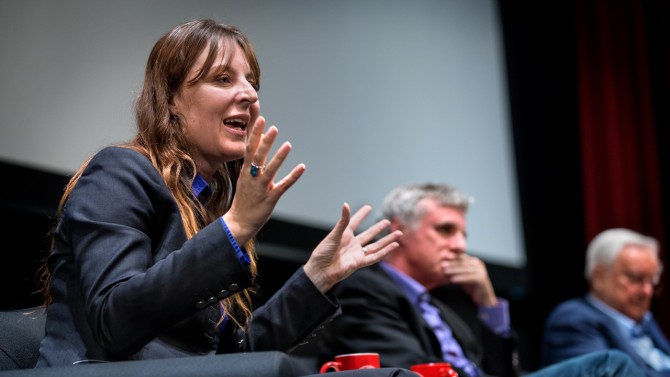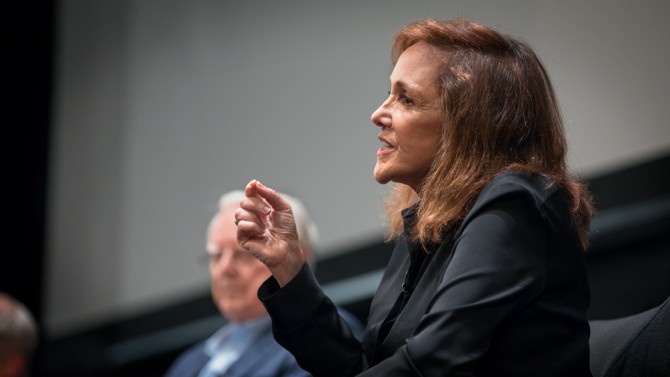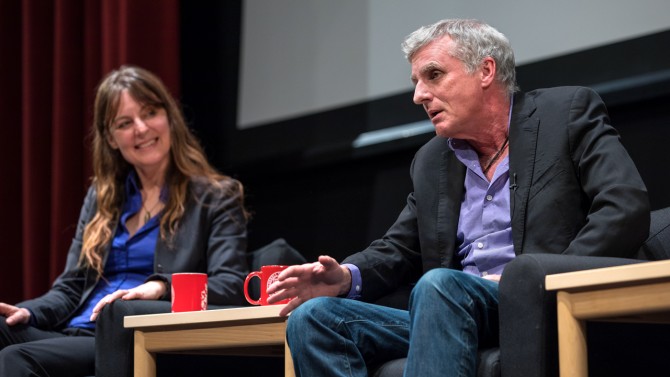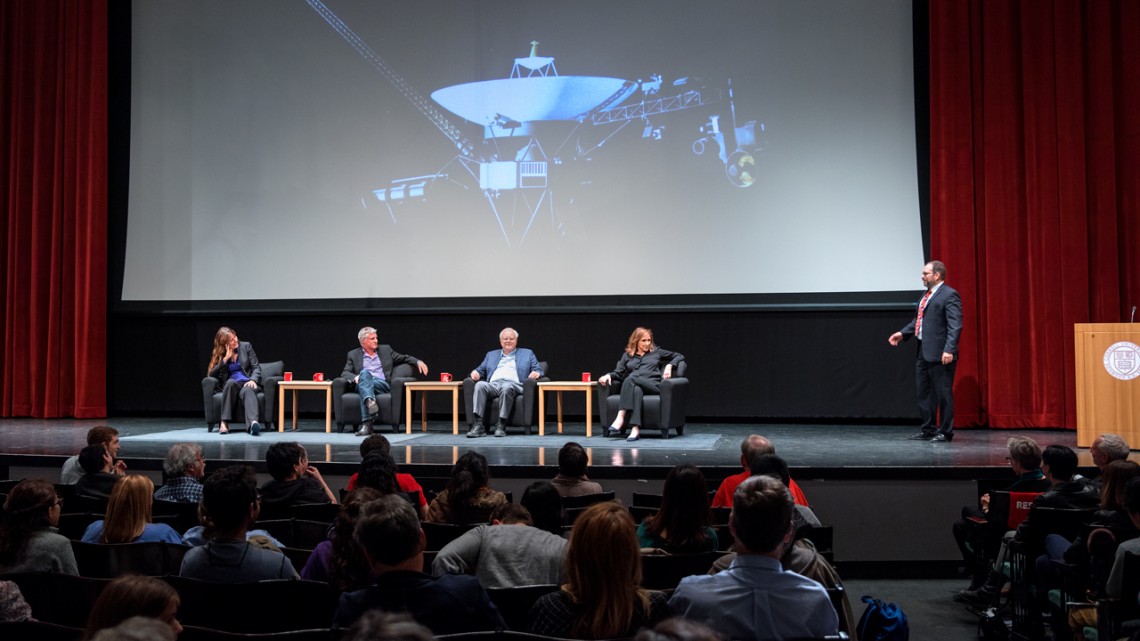
From left, Lisa Kaltenegger, Steve Squyres, Frank Drake and Ann Druyan listen to moderator Jonathan Lunine at the Oct. 19 panel discussion on the Voyager mission.
Cornellians celebrate the Voyagers’ historic Golden Record
By Blaine Friedlander
Four decades after NASA’s twin Voyager spacecraft launched from Cape Canaveral, about 800 Cornellians gathered at Bailey Hall Oct. 19 to celebrate the unprecedented mission, its famous Golden Record and the university’s role in the mission.
A panel focused on the Golden Record – a 12-inch, gold-covered copper record containing salutations to the universe, international music and images of life on Earth – that was affixed to the Voyagers so aliens could grasp something about our world. The record’s shelf life: 1 to 5 billion years.
Radio astronomy pioneer Frank Drake ’52, chairman emeritus of the SETI (Search for Extraterrestrial Intelligence) Institute and a former Cornell professor of astronomy, joined Ann Druyan, a Peabody and Emmy award winning writer and producer, creative director of NASA’s Voyager Interstellar Message; Steve Squyres ’81, Cornell’s James A. Weeks Professor and principal investigator of the Mars Exploration Rovers mission; and Lisa Kaltenegger associate professor of astronomy and director of Cornell’s Carl Sagan Institute, for “40 Years of Cosmic Discovery: Celebrating the Voyager Missions and Humanity’s Message to Space.”
Jonathan Lunine, the David C. Duncan Professor in the Physical Sciences and director of the Cornell Center for Astrophysics and Planetary Science, moderated the panel.
“The Voyager missions profoundly influenced every planetary scientist working today,” Lunine said.
Drake and Druyan reminisced about creating the Golden Record at Cornell with the late astronomer Carl Sagan. “That turned out to be one of the most beautiful events in my life,” Drake said, and described how university faculty and staff picked images that portrayed life on Earth.
“We all had the sense that we were doing something very important. We would create a record of the existence of … our civilization that would last longer than the Earth itself. It might never be found, but if it did, it would be the only thing in the universe that would [have recorded] memories of the history of this civilization,” Drake said. “And that weighed heavily on us, but inspired us.
“In the end NASA was happy with what we did. We saw the record completed – essentially untouched and launched into space,” Drake said.
Druyan explained how the Jet Propulsion Laboratory receives inquiries daily about Voyager and its Golden Record. “Nothing they have ever done has elicited so much interest and feeling as the Voyager record,” she said.
“Voyager – the mission and the message – was really the essence of Carl Sagan,” said Druyan, Sagan’s widow. “The idea that our scientific ability and curiosity, our intellect, our cleverness could be paired seamlessly with the music and our art and our dream of unity of a planet that reflects not just on one nation, not just the chauvinism of one people, but from all the beauty made on all the continents on Earth.”
Squyres experienced the Voyager era as a 23-year-old Cornell graduate student. As the craft flew through the Jupiter system in 1979, images were downloaded at the Jet Propulsion Laboratory. A scientific surprise: Voyager’s navigation images of the moon Io revealed seven active volcanoes. “That was just the first among many groundbreaking images,” Squyres said. “It is exemplary of what a class act the Voyager was.”
Kaltenegger said she was scientifically inspired by an iconic image taken by Voyager: Earth, seen as the pale blue dot. “It’s still mesmerizing,” she said, adding that the Voyager spacecraft is still the only human-touched object to travel beyond the bounds of the solar system.
In today’s world, however, we can explore even further – we can find planets orbiting alien suns and analyze what’s in the air of other worlds. “We have the tools in hand to actually spot signs of life on other planets, if they exist, without going there … and we are building telescopes big enough to see them,” she said.
An audience member asked what Sagan would be doing today if he were alive. Druyan replied: “He would be at the Carl Sagan Institute, although it would have another name. And he would be working with Lisa and loving her as I do and be really inspired by her commitment.”
“He would be searching for life elsewhere. That was the question that was the second-dearest to his heart. The dearest was whether or not we are going to get our act together as a species and protect the life on this world,” she said.
Looking to the future, the panelists suggested how humanity might explore space. Kaltenegger proposed expanding searches for exoplanets, while Squyres advocated obtaining Mars samples and taking them apart, “molecule by molecule,” to see if there is life there. Druyan urged study of the moons Enceladus and Europa, while Drake suggested sending a spacecraft to visit the focal point of the sun to use the sun as a gigantic lens. “The aim is to see other planets and the continents, and whatever else is there – we need to do that,” he said.
Media Contact
Get Cornell news delivered right to your inbox.
Subscribe